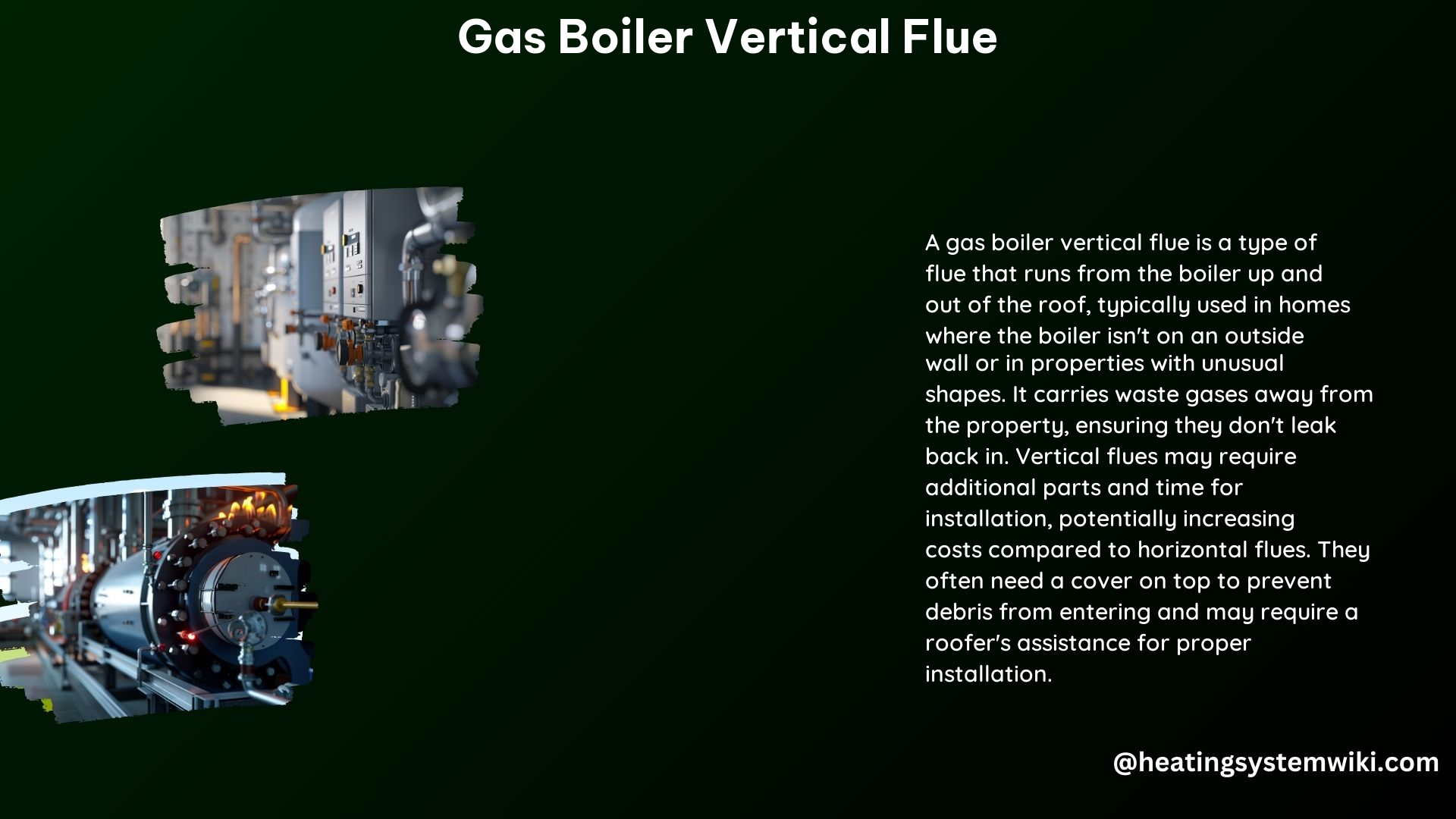A gas boiler vertical flue is a critical component of a heating system, responsible for the safe removal of waste gases produced by the boiler. This comprehensive guide delves into the intricate details of installing, maintaining, and ensuring the safety of a gas boiler vertical flue, providing a valuable resource for homeowners, DIY enthusiasts, and HVAC professionals.
Installation of a Gas Boiler Vertical Flue
The Installation Process
-
Roof Penetration: The installation process begins with creating a precise hole in the roof, carefully measured and positioned to accommodate the vertical flue. This step requires meticulous planning to ensure a secure and watertight seal.
-
Flue Positioning: The flue must be angled correctly, typically at a 3-degree incline, to prevent dripping and ensure efficient gas flow. Proper positioning is crucial for the flue’s optimal performance.
-
Flue Material and Sealing: Gas boiler vertical flues are typically constructed from heat-resistant materials, such as stainless steel or aluminum, capable of withstanding high temperatures. The flue must be securely sealed to prevent any leaks or gas escapes.
-
Installation by Certified Professionals: It is highly recommended that the installation of a gas boiler vertical flue be carried out by a Gas Safe Registered engineer. These professionals have the necessary expertise to ensure that all safety regulations and building codes are strictly adhered to.
Vertical Flue Cover
-
Purpose of the Cover: The vertical flue requires a cover at the top to prevent the ingress of rain, leaves, snow, and other debris. This cover allows the safe and unobstructed emission of waste gases while keeping the flue clear.
-
Cover Design Considerations: The cover must be designed to optimize gas flow while effectively blocking external elements. Factors such as material, size, and shape are carefully considered to ensure the cover’s efficiency and durability.
Clearance Requirements for a Gas Boiler Vertical Flue

Minimum Clearance from Roof Pitch
- Clearance Specification: The minimum clearance from the roof pitch must be at least 300 mm (approximately 12 inches). This distance ensures that the flue is not too close to the roof, allowing for safe and unimpeded gas emission.
Clearance from Other Objects
-
Clearance from Ground Level: If the vertical flue is facing a public thoroughfare or frequently used pathway, it must be at least 2.1 m (approximately 6.9 feet) above ground level.
-
Clearance from Openings: The flue must be positioned at least 300 mm (approximately 12 inches) below, above, or alongside any opening windows, air vents, or other ventilation openings.
-
Clearance from Gutters and Pipes: The flue must be at least 75 mm (approximately 3 inches) below any guttering, drain pipes, or soil pipes.
-
Clearance from Eaves: The flue must be positioned at least 200 mm (approximately 8 inches) below the eaves (roof overhang).
Preventing Rain and Debris Ingress
Vertical Flue Cover Design
-
Material and Construction: The cover at the top of the vertical flue is typically made from weather-resistant materials, such as stainless steel or aluminum, to withstand the elements and maintain its integrity over time.
-
Airflow Optimization: The cover’s design is carefully engineered to allow for efficient gas flow while effectively blocking the entry of rain, leaves, snow, and other debris.
Regular Maintenance
-
Inspection and Cleaning: Regularly inspecting the vertical flue and removing any accumulated debris, such as leaves or nesting materials, is crucial to ensure the flue’s continued functionality and safety.
-
Seasonal Checks: It is recommended to perform thorough inspections and cleaning, especially before the winter season, to prepare the flue for potential heavy snowfall or strong winds.
Technical Specifications
Flue Materials
-
Heat-Resistant Materials: Gas boiler vertical flues are typically constructed from materials that can withstand high temperatures, such as stainless steel, aluminum, or specialized heat-resistant plastics.
-
Corrosion Resistance: The flue materials must also be resistant to corrosion, as they are exposed to various environmental factors, including moisture, chemicals, and temperature fluctuations.
Flue Size
-
Boiler Capacity: The size of the vertical flue is determined by the capacity of the gas boiler it is serving. Larger boilers will require a larger-diameter flue to accommodate the increased volume of waste gases.
-
Flue Length and Bends: The maximum travel length of the vertical flue is decreased by 1 meter for every bend it incorporates. This is to ensure that the flue maintains the necessary airflow and pressure for efficient gas removal.
Gas Flow Optimization
-
Flue Design: The vertical flue is designed with specific dimensions and airflow patterns to facilitate the smooth and unobstructed removal of waste gases from the boiler.
-
Pressure and Velocity: The flue’s design takes into account the pressure and velocity requirements for the safe and effective discharge of the waste gases, ensuring that they are expelled at a safe distance from the property.
By following the detailed guidelines and technical specifications outlined in this comprehensive guide, homeowners, DIY enthusiasts, and HVAC professionals can ensure the proper installation, maintenance, and safe operation of a gas boiler vertical flue. Adhering to these best practices will not only enhance the efficiency of the heating system but also safeguard the well-being of the occupants and the surrounding environment.
References:
- Tomkat Gas Training. (2023). Vertical Flue Installation. YouTube.
- Boiler Central. (n.d.). Boiler Flues – Ultimate Guide with Boiler Flue Regulations & Rules.
- Ideal Heating. (n.d.). What is a Boiler Flue and How Do They Work?
- Gas Angel Heating. (n.d.). Boiler Flues: What is a Vertical Flue? What is a Horizontal Flue?
